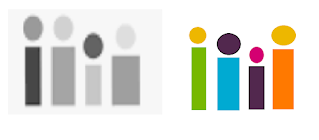Recently I had the opportunity to be involved in the design of a logo to be used for internal, diversity and inclusion-related events where I work.
Now, here are some of the constraints. The design will be of an icon - size 550 x 330 pixels - that will appear in a webpage and in an email newsletter. We don't have masses of space nor the option of fine detail and lines of text that would be available on a poster design or a billboard. This clearly will influence the design.
Now, a common rule when designing logos is that you first design in black and white, so that the design's effectiveness is not dependent on colour. This is because often, things created in colour get photocopied in black and white and you don't want to end up with a meaningless or unreadable image. However, in this case, as the design will only appear on computer screens and almost never printed black and white, this rule is not particularly applicable.
I kind of liked this, though it is rather impersonal, as it shows interconnectedness and can indicate diversity abstractly. This is one of the difficulties of a logo or icon for diversity and inclusion in general. It would be much easier to design something for one specific group, such as for disability-related events or Indigenous events. In this case, we either need to show D&I abstractly or in a way that includes a wide variety of specific diversities.
So realizing that the above was too detailed for the size requirement, I contemplated a four piece puzzle but that seemed to lose too much.
So I looked up diversity and inclusion logos on Google.
Incidentally, in keeping with the black and white logo creation, Google has a monochrome extension which, by clicking an icon, turns whatever webpage you are viewing into monochrome!
There were several ideas which interested me. Here's one I found (left image) and I drew up a rough equivalent, and added in colour based on the branding guidelines (right image). Not too thrilled by this for our purposes.
So then I thought, what if I make a person using the outline of our province, and using the official colours? This is my second try:
Pretty snazzy, uh? The colours are all the primary brand colours, representing the diversity of our geography. For the record, this image is a professionally fixed up version that my oldest son did in Adobe Illustrator based in the version that I made using Paint.
So then I thought, I really need several people together. I duplicated the person, simplified the colour blocking, and took the opportunity to use three different skin colours for the three faces.
At this point, let's review. The faces represent people of different races. The colours on the bodies show diversity in general, but also might hint at the colours of the rainbow and thereby represent sexual diversity and gender expansiveness. I use the word hint on purpose. With this kind of logo which needs to be broadly inclusive, and where the detail level does not allow much detail, you can't necessarily directly show every group. Sometimes you can only hint at things.
I did however want to be clear about including people with disabilities in some way. Often, the go to for this is a person in a wheelchair, even in cases and at detail levels where it would be possible to show other types of disability. Not really what I want to use if I had other ideas, but in this case, as the people do not even have limbs, a wheelchair might be the best option. It can also be done a bit subtly - present without being a dominant feature.
So to shorten up the story, there were more things to consider:
- People aren't all the same size. True, I had already made the middle person a slightly different width, but they are all the same height.
- It would be good if the different employee resource groups in our workplace could each see themselves in the graphic, obviously without having too much detail. This would mean adding a hint or reference to women and to Indigenous peoples.
- As well, it seems that while these colours are roughly parallel to the Pride colours, albeit different variations of the same colours, they are nowhere near the right order. What if I took the pink and blue and added a bit of white to end up with the transgender colours as stripes on a shirt. That would more clearly link to the LGBTQ employee resource group as well as referencing transgender people who typically face far more challenges than gay and lesbian people do.
- Even without looking closely at the finer details, this is obviously a diverse group. With a closer look, some of the finer details become evident.
- The colorfulness references diversity overall.
- The four people are the shape of Alberta! Perfect for this workplace.
- The icon visually references all of the official ERGs: Black, Disability, Indigenous, LGBTQ, Multicultural, and Women
- The people are not "one-dimensional" -- there are several which are linked to more than one element of diversity - for example, the black transgender person and the woman of colour.
- The people are a variety of heights and widths
- Suitable for all D&I events and would become readily identified with Diversity and Inclusion events. This to me was the goal – an icon that is clearly and specifically D&I.
Thoughts? Use the Comment section below to give feedback.






No comments:
Post a Comment